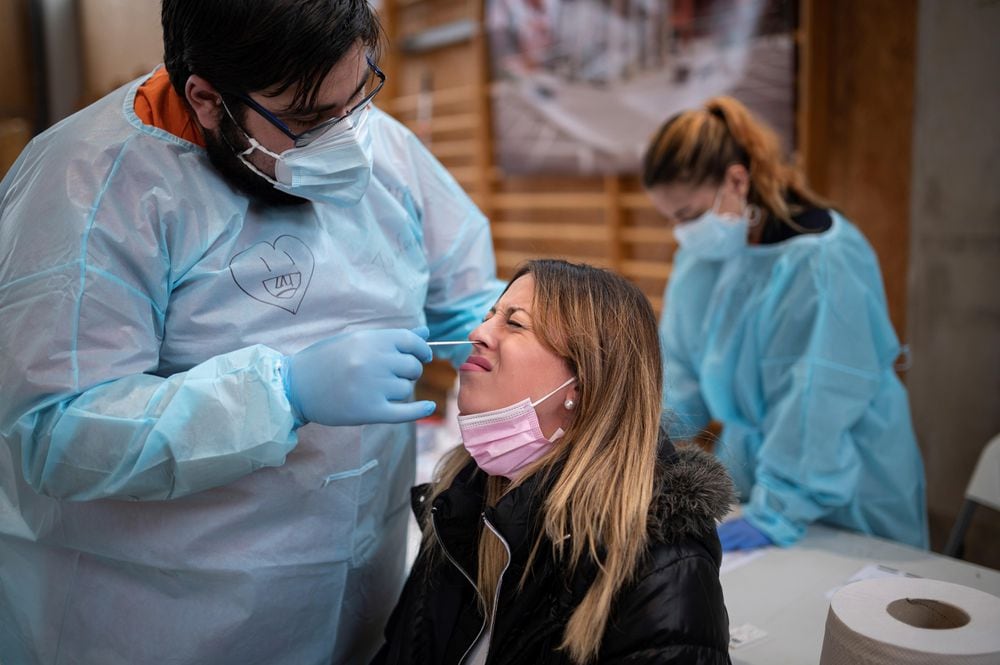The British variant of covid-19 is already spreading through the Community of Madrid. In some areas, the presence reaches 50% of the cases detected. This is how the Deputy Minister of Health, Antonio Zapatero explained it this Friday: “In some hospitals such as Gregorio Marañón, positivity [de esta variante] it is 20%, 22% in Móstoles, 14.8% in Ramón y Cajal, 22.7% in La Paz and in places like Collado Villalba and Moralzarzal it is 57% and 50% ”. Although in these last two municipalities “there are not many cases”, pointed out Zapatero, the data “gives an idea of what is happening.” Four of the five cases under investigation of the Brazilian variant have been negative, he added during the same intervention, while a sample of the South African vein continues to be analyzed.
The deputy counselor believes that, even though the dismissal of these cases under study is good news, “the appearance of these variants in Galicia and Catalonia usually brings bad news, we fear that there may be more cases.”
Another positive issue, but not definitive, is the drop in income curves and new infections in the region. “It is a change in trend as the number of cases decreases this week, a progressive decrease. The cumulative incidence is today at 860, even so it is high and the level of transmission is still high and it must be borne in mind, ”said Zapatero.
Faced with this situation, the Community of Madrid has decided this Friday to expand the capacity for the terraces, from four to six people; establish the obligation to wear a mask in bars and restaurants – until now it was only a recommendation – and also make ventilation, mechanical or natural, mandatory in those establishments. These measures have already entered into force, since they were published this morning in the official community bulletin. In addition, Health has reviewed the basic health areas in which there will be limitation to mobility as of next Monday (72 areas and 28 locations) and despite the fact that there is still no scientific evidence or data show that these perimeter films work.
The Deputy Minister of Public Health and the COVID-19 Plan of the Community of Madrid, Antonio Zapatero. On video, his statements on the incidence of the British strain.
—
These measures, in force until midnight on Friday, February 12, “have technical justification,” said the deputy counselor: “We have a very detailed monitoring of where infections occur and it is not mainly in the hospitality industry, but in the family and in social gatherings ”. This statement clashes with the data provided by the Community of Madrid itself to the Ministry of Health. Every week the ministry publishes a report with the monitoring of the variables to measure the risk in the autonomous regions, and last Thursday it indicated a traceability of 16.1% of the cases in Madrid. That is, according to this number, Madrid does not know the origin of 83.9% of its infections. However, Elena Andradas, general director of Public Health in the region, points out that “the calculation of these indicators is not consensual from a technical point of view.” It has also specified that “to reflect true traceability, the outbreaks that are being investigated should be included and that data has not been incorporated by the Community.”
On the other hand, the Ministry of Health has decided to maintain the threshold from which it sets tougher restrictions on 1,000 cases per 100,000 inhabitants in the last 14 days. A hairpin that has been going up and down for months and that, in recent weeks, with the curves soaring, has only increased. That is, the more contagions there were and the more hospital occupancy there was, the higher the cut-off figure to impose restrictions. The last change was to leave it “in the average of the Community”, and it varied every week. Now that incidence is down, that number remains at 1,000. A decision that Andradas justifies with the other criteria to impose limitations, such as “where the infections occur” and if they have “controlled” that transmission.
Slight drop in the curves of cases and hospital admissions
Last Friday, close to 1,000 accumulated incidence cases and with ICUs at 150% occupancy, Madrid decided not to change the restrictive measures. Neither new nor modification of existing ones. “Let’s see how the week evolves,” said then the Deputy Minister of Health, Antonio Zapatero. And the week has given a slight respite in the contagion curve, in the positivity of diagnostic tests – it has dropped six points, from 20.88% to 14.96% – and has lowered the cumulative incidence to 860, according to Zapatero has encrypted, a number that is still more than three times above the maximum level of danger, that of extreme risk, in this parameter set by the Ministry of Health (250). It is the fifth community with this highest variable, after the Valencian Community (1,245), Castilla y León (1,177), La Rioja (1,160), Castilla-La Mancha (981) and Melilla (949), according to the latest data from the ministry of this Thursday.
The improvement in these variables are not, however, an immediate relief for the biggest problem at this time of the pandemic, the care capacity of the centers, in which admissions have been reduced in the last seven days compared to the previous week —4,257 to 3,162— and the overall number of admitted patients has also been falling for three days, 4,094 with data from this Thursday. But where this apparently stable change has not yet reached is in the intensive care units, as the deputy counselor recalled. They are always at least two weeks behind the rest of the variables, when there is a change in the trend. This is due to the evolution of the disease itself, the period of 14 days between contagion, the appearance of symptoms and the worsening, if it occurs, of the infection.
The ICUs have slightly increased global occupancy compared to the previous week: 727 critics this Thursday with respect to the 721 of last Friday, according to the daily data of the Society of Intensive Medicine of Madrid; and 318 new seriously ill patients have needed one of these beds in the last six days. These services are above 150% of their structural capacity, without counting on other reconvertible areas such as operating rooms or resuscitation units. Many of them, in most centers, have already stopped their usual activity to be able to care for covid patients, which leaves, therefore, without covering the rest of pathologies.
And the number of deaths has not started the decline either. Since last Thursday, with no data yet for this Friday, 451 people have died from coronavirus in the Community, 477 did so the previous week. Only since the beginning of the year mortuary health data of the Ministry of Health registered 1,703 deaths from the virus. The best tool now to stop all the parameters is vaccination, which Zapatero has already estimated at 250,000: “70,000 second doses, and today [por este viernes] We will exceed the goal of ending 80,000 completed patterns. This week, more than 60,000 second doses will be given in homes for the elderly and disabled, and it is expected that by mid-February groups 1 and 2 will be vaccinated. And whenever we receive more vaccines, we will resume the first doses in health professionals at that time ”.
Information about the coronavirus
– Here you can follow the last hour on the evolution of the pandemic
– Restrictions search engine: What can I do in my municipality?
– This is how the coronavirus curve evolves in the world
– Download the tracking application for Spain
– Guide to action against the disease
–


